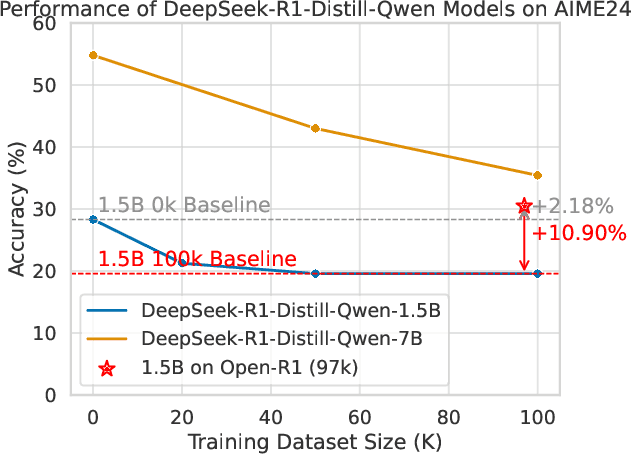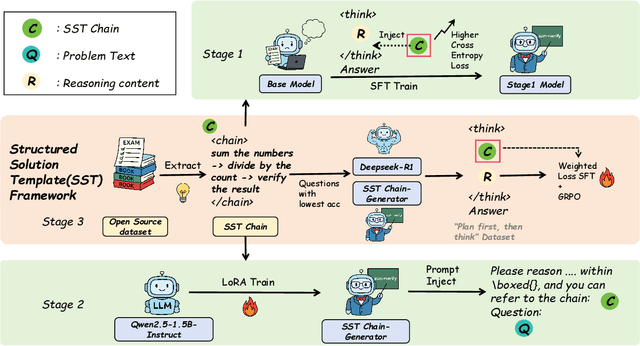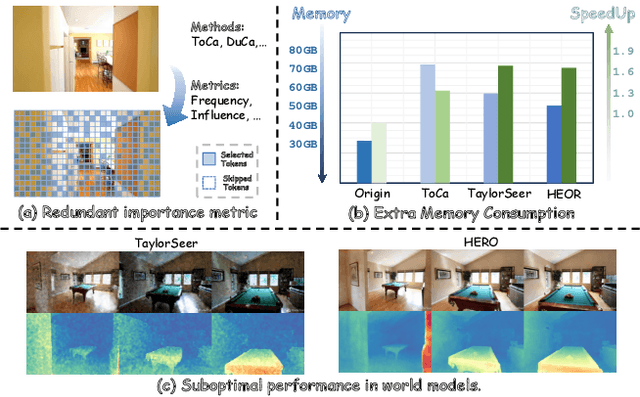Xinyu Wang
Nav-EE: Navigation-Guided Early Exiting for Efficient Vision-Language Models in Autonomous Driving
Oct 02, 2025Abstract:Vision-Language Models (VLMs) are increasingly applied in autonomous driving for unified perception and reasoning, but high inference latency hinders real-time deployment. Early-exit reduces latency by terminating inference at intermediate layers, yet its task-dependent nature limits generalization across diverse scenarios. We observe that this limitation aligns with autonomous driving: navigation systems can anticipate upcoming contexts (e.g., intersections, traffic lights), indicating which tasks will be required. We propose Nav-EE, a navigation-guided early-exit framework that precomputes task-specific exit layers offline and dynamically applies them online based on navigation priors. Experiments on CODA, Waymo, and BOSCH show that Nav-EE achieves accuracy comparable to full inference while reducing latency by up to 63.9%. Real-vehicle integration with Autoware Universe further demonstrates reduced inference latency (600ms to 300ms), supporting faster decision-making in complex scenarios. These results suggest that coupling navigation foresight with early-exit offers a viable path toward efficient deployment of large models in autonomous systems. Code and data are available at our anonymous repository: https://anonymous.4open.science/r/Nav-EE-BBC4
Towards General Agentic Intelligence via Environment Scaling
Sep 16, 2025Abstract:Advanced agentic intelligence is a prerequisite for deploying Large Language Models in practical, real-world applications. Diverse real-world APIs demand precise, robust function-calling intelligence, which needs agents to develop these capabilities through interaction in varied environments. The breadth of function-calling competence is closely tied to the diversity of environments in which agents are trained. In this work, we scale up environments as a step towards advancing general agentic intelligence. This gives rise to two central challenges: (i) how to scale environments in a principled manner, and (ii) how to effectively train agentic capabilities from experiences derived through interactions with these environments. To address these, we design a scalable framework that automatically constructs heterogeneous environments that are fully simulated, systematically broadening the space of function-calling scenarios. We further adapt a two-phase agent fine-tuning strategy: first endowing agents with fundamental agentic capabilities, then specializing them for domain-specific contexts. Extensive experiments on agentic benchmarks, tau-bench, tau2-Bench, and ACEBench, demonstrate that our trained model, AgentScaler, significantly enhances the function-calling capability of models.
WebSailor-V2: Bridging the Chasm to Proprietary Agents via Synthetic Data and Scalable Reinforcement Learning
Sep 16, 2025Abstract:Transcending human cognitive limitations represents a critical frontier in LLM training. Proprietary agentic systems like DeepResearch have demonstrated superhuman capabilities on extremely complex information-seeking benchmarks such as BrowseComp, a feat previously unattainable. We posit that their success hinges on a sophisticated reasoning pattern absent in open-source models: the ability to systematically reduce extreme uncertainty when navigating vast information landscapes. Based on this insight, we introduce WebSailor, a complete post-training methodology designed to instill this crucial capability. Our approach involves generating novel, high-uncertainty tasks through structured sampling and information obfuscation, RFT cold start, and an efficient agentic RL training algorithm, Duplicating Sampling Policy Optimization (DUPO). With this integrated pipeline, WebSailor significantly outperforms all open-source agents in complex information-seeking tasks, matching proprietary agents' performance and closing the capability gap.
Scaling Agents via Continual Pre-training
Sep 16, 2025Abstract:Large language models (LLMs) have evolved into agentic systems capable of autonomous tool use and multi-step reasoning for complex problem-solving. However, post-training approaches building upon general-purpose foundation models consistently underperform in agentic tasks, particularly in open-source implementations. We identify the root cause: the absence of robust agentic foundation models forces models during post-training to simultaneously learn diverse agentic behaviors while aligning them to expert demonstrations, thereby creating fundamental optimization tensions. To this end, we are the first to propose incorporating Agentic Continual Pre-training (Agentic CPT) into the deep research agents training pipeline to build powerful agentic foundational models. Based on this approach, we develop a deep research agent model named AgentFounder. We evaluate our AgentFounder-30B on 10 benchmarks and achieve state-of-the-art performance while retains strong tool-use ability, notably 39.9% on BrowseComp-en, 43.3% on BrowseComp-zh, and 31.5% Pass@1 on HLE.
WebResearcher: Unleashing unbounded reasoning capability in Long-Horizon Agents
Sep 16, 2025Abstract:Recent advances in deep-research systems have demonstrated the potential for AI agents to autonomously discover and synthesize knowledge from external sources. In this paper, we introduce WebResearcher, a novel framework for building such agents through two key components: (1) WebResearcher, an iterative deep-research paradigm that reformulates deep research as a Markov Decision Process, where agents periodically consolidate findings into evolving reports while maintaining focused workspaces, overcoming the context suffocation and noise contamination that plague existing mono-contextual approaches; and (2) WebFrontier, a scalable data synthesis engine that generates high-quality training data through tool-augmented complexity escalation, enabling systematic creation of research tasks that bridge the gap between passive knowledge recall and active knowledge construction. Notably, we find that the training data from our paradigm significantly enhances tool-use capabilities even for traditional mono-contextual methods. Furthermore, our paradigm naturally scales through parallel thinking, enabling concurrent multi-agent exploration for more comprehensive conclusions. Extensive experiments across 6 challenging benchmarks demonstrate that WebResearcher achieves state-of-the-art performance, even surpassing frontier proprietary systems.
Boosting Data Utilization for Multilingual Dense Retrieval
Sep 11, 2025Abstract:Multilingual dense retrieval aims to retrieve relevant documents across different languages based on a unified retriever model. The challenge lies in aligning representations of different languages in a shared vector space. The common practice is to fine-tune the dense retriever via contrastive learning, whose effectiveness highly relies on the quality of the negative sample and the efficacy of mini-batch data. Different from the existing studies that focus on developing sophisticated model architecture, we propose a method to boost data utilization for multilingual dense retrieval by obtaining high-quality hard negative samples and effective mini-batch data. The extensive experimental results on a multilingual retrieval benchmark, MIRACL, with 16 languages demonstrate the effectiveness of our method by outperforming several existing strong baselines.
Can Structured Templates Facilitate LLMs in Tackling Harder Tasks? : An Exploration of Scaling Laws by Difficulty
Aug 26, 2025



Abstract:Structured, procedural reasoning is essential for Large Language Models (LLMs), especially in mathematics. While post-training methods have improved LLM performance, they still fall short in capturing deep procedural logic on complex tasks. To tackle the issue, in this paper, we first investigate this limitation and uncover a novel finding: a Scaling Law by Difficulty, which reveals that model performance follows a U-shaped curve with respect to training data complexity -- excessive low-difficulty data impedes abstraction, while high-difficulty data significantly enhances reasoning ability. Motivated by this, we propose the Structured Solution Template (SST) framework, which uses solution templates and a curriculum of varied difficulty to explicitly teach procedural reasoning. Specifically, SST comprises (1) fine-tuning with structured solution-template chains and dynamically weighted loss to prioritize procedural logic, (2) prompt-time injection of solution templates as cognitive scaffolds to guide inference, and (3) integrated curriculum fine-tuning that explicitly teaches the model to self-plan - execute - self-correct. Experiments on GSM8K, AIME24, and new Dynamic En benchmark show that SST significantly improves both accuracy and efficiency, especially on harder problems.
HERO: Hierarchical Extrapolation and Refresh for Efficient World Models
Aug 25, 2025



Abstract:Generation-driven world models create immersive virtual environments but suffer slow inference due to the iterative nature of diffusion models. While recent advances have improved diffusion model efficiency, directly applying these techniques to world models introduces limitations such as quality degradation. In this paper, we present HERO, a training-free hierarchical acceleration framework tailored for efficient world models. Owing to the multi-modal nature of world models, we identify a feature coupling phenomenon, wherein shallow layers exhibit high temporal variability, while deeper layers yield more stable feature representations. Motivated by this, HERO adopts hierarchical strategies to accelerate inference: (i) In shallow layers, a patch-wise refresh mechanism efficiently selects tokens for recomputation. With patch-wise sampling and frequency-aware tracking, it avoids extra metric computation and remain compatible with FlashAttention. (ii) In deeper layers, a linear extrapolation scheme directly estimates intermediate features. This completely bypasses the computations in attention modules and feed-forward networks. Our experiments show that HERO achieves a 1.73$\times$ speedup with minimal quality degradation, significantly outperforming existing diffusion acceleration methods.
HiCache: Training-free Acceleration of Diffusion Models via Hermite Polynomial-based Feature Caching
Aug 23, 2025Abstract:Diffusion models have achieved remarkable success in content generation but suffer from prohibitive computational costs due to iterative sampling. While recent feature caching methods tend to accelerate inference through temporal extrapolation, these methods still suffer from server quality loss due to the failure in modeling the complex dynamics of feature evolution. To solve this problem, this paper presents HiCache, a training-free acceleration framework that fundamentally improves feature prediction by aligning mathematical tools with empirical properties. Our key insight is that feature derivative approximations in Diffusion Transformers exhibit multivariate Gaussian characteristics, motivating the use of Hermite polynomials-the potentially theoretically optimal basis for Gaussian-correlated processes. Besides, We further introduce a dual-scaling mechanism that ensures numerical stability while preserving predictive accuracy. Extensive experiments demonstrate HiCache's superiority: achieving 6.24x speedup on FLUX.1-dev while exceeding baseline quality, maintaining strong performance across text-to-image, video generation, and super-resolution tasks. Core implementation is provided in the appendix, with complete code to be released upon acceptance.
An Entity Linking Agent for Question Answering
Aug 05, 2025Abstract:Some Question Answering (QA) systems rely on knowledge bases (KBs) to provide accurate answers. Entity Linking (EL) plays a critical role in linking natural language mentions to KB entries. However, most existing EL methods are designed for long contexts and do not perform well on short, ambiguous user questions in QA tasks. We propose an entity linking agent for QA, based on a Large Language Model that simulates human cognitive workflows. The agent actively identifies entity mentions, retrieves candidate entities, and makes decision. To verify the effectiveness of our agent, we conduct two experiments: tool-based entity linking and QA task evaluation. The results confirm the robustness and effectiveness of our agent.
 Add to Chrome
Add to Chrome Add to Firefox
Add to Firefox Add to Edge
Add to Edge